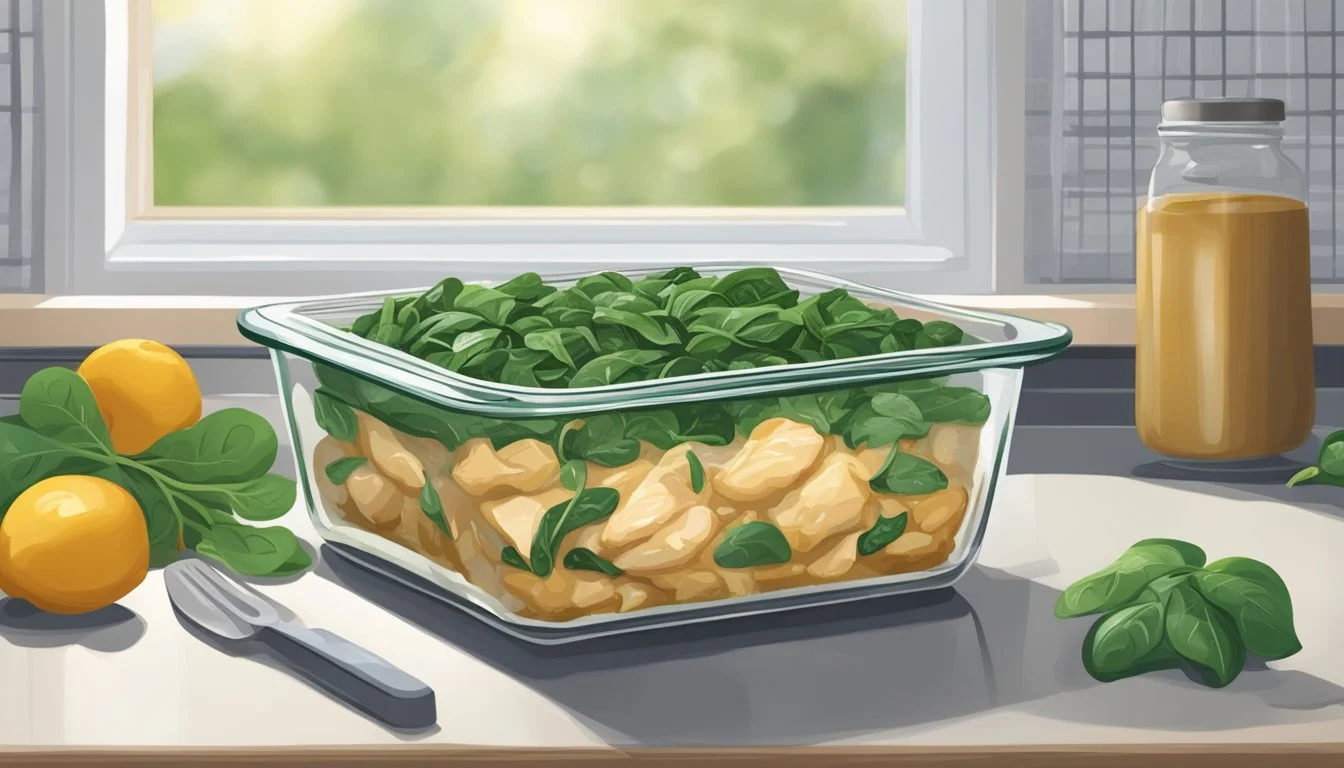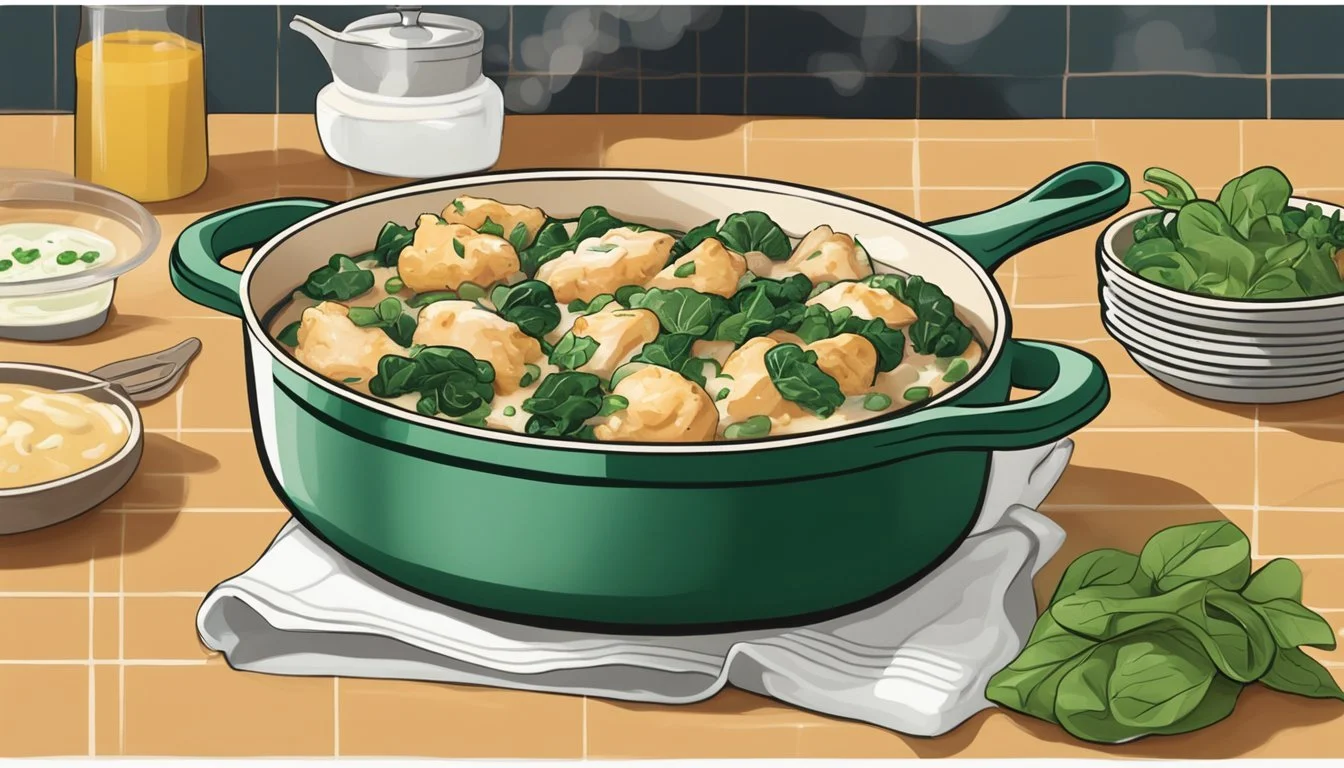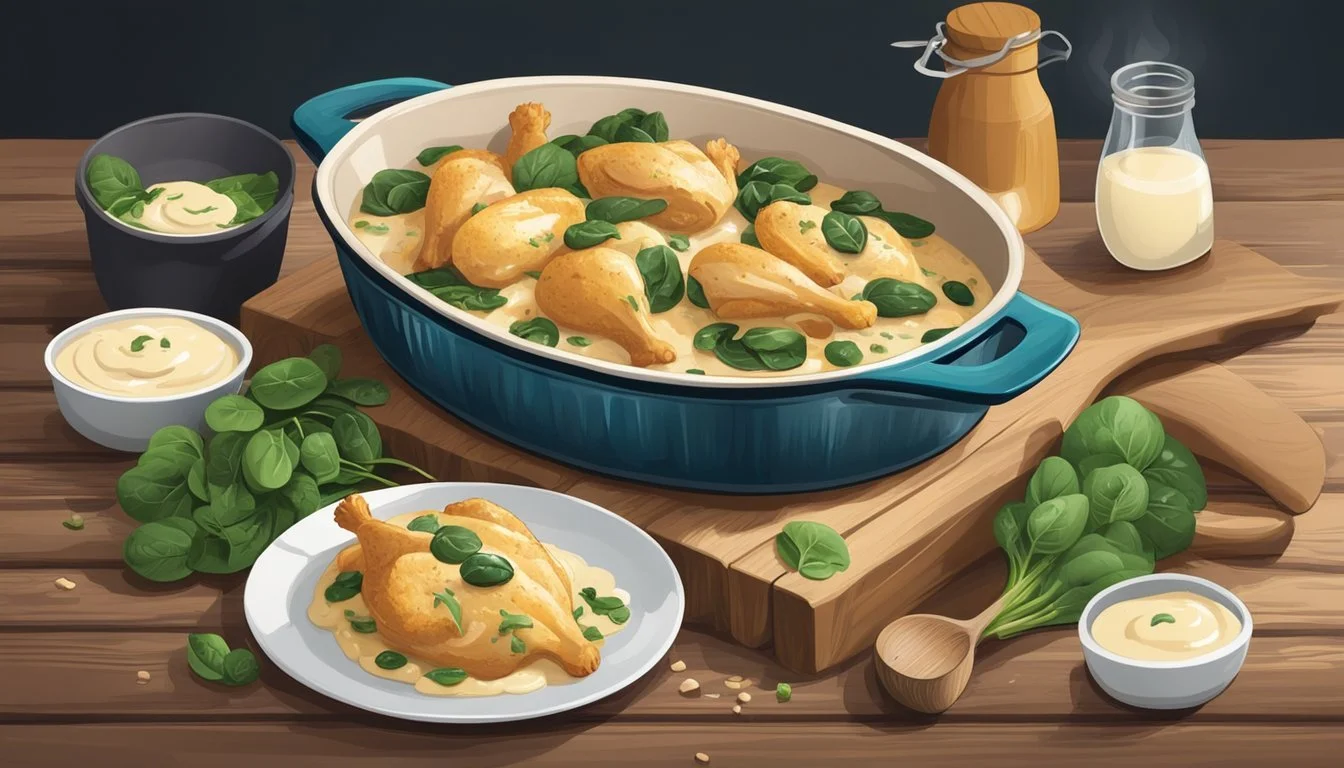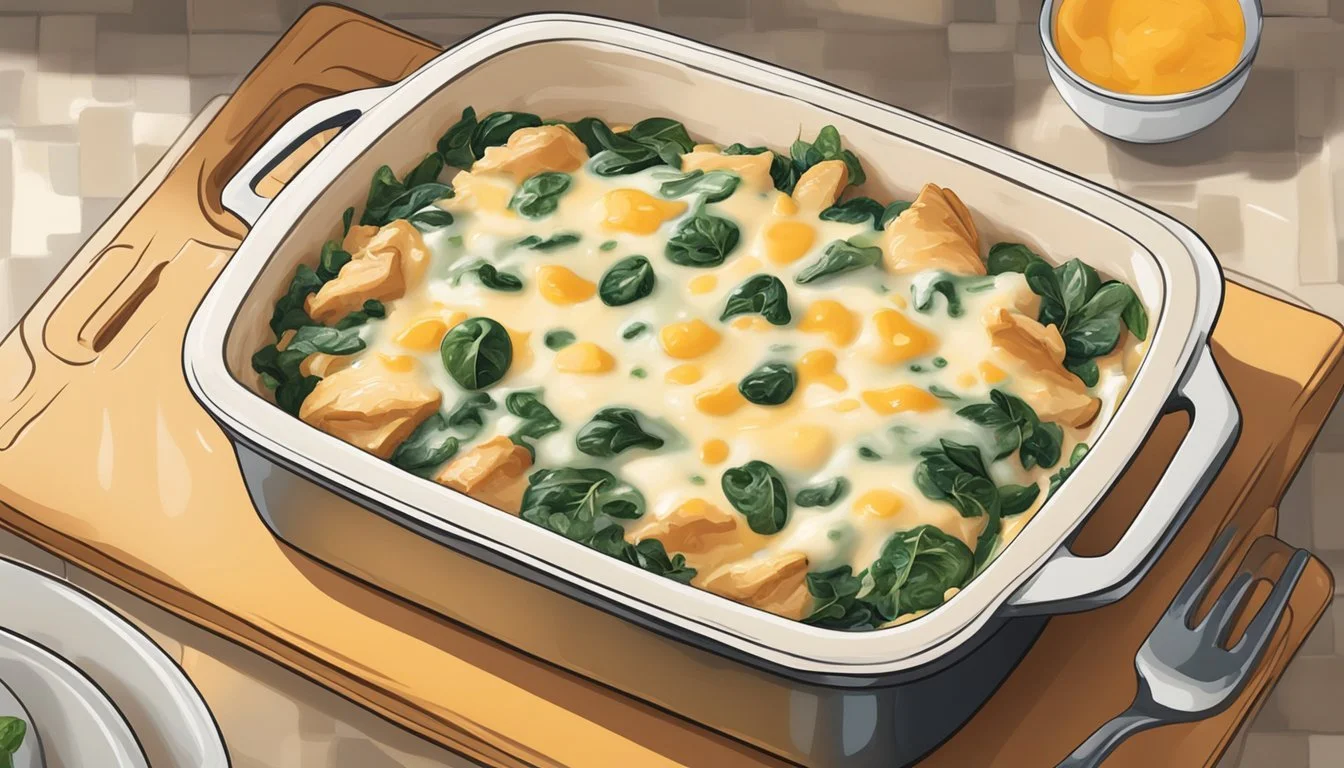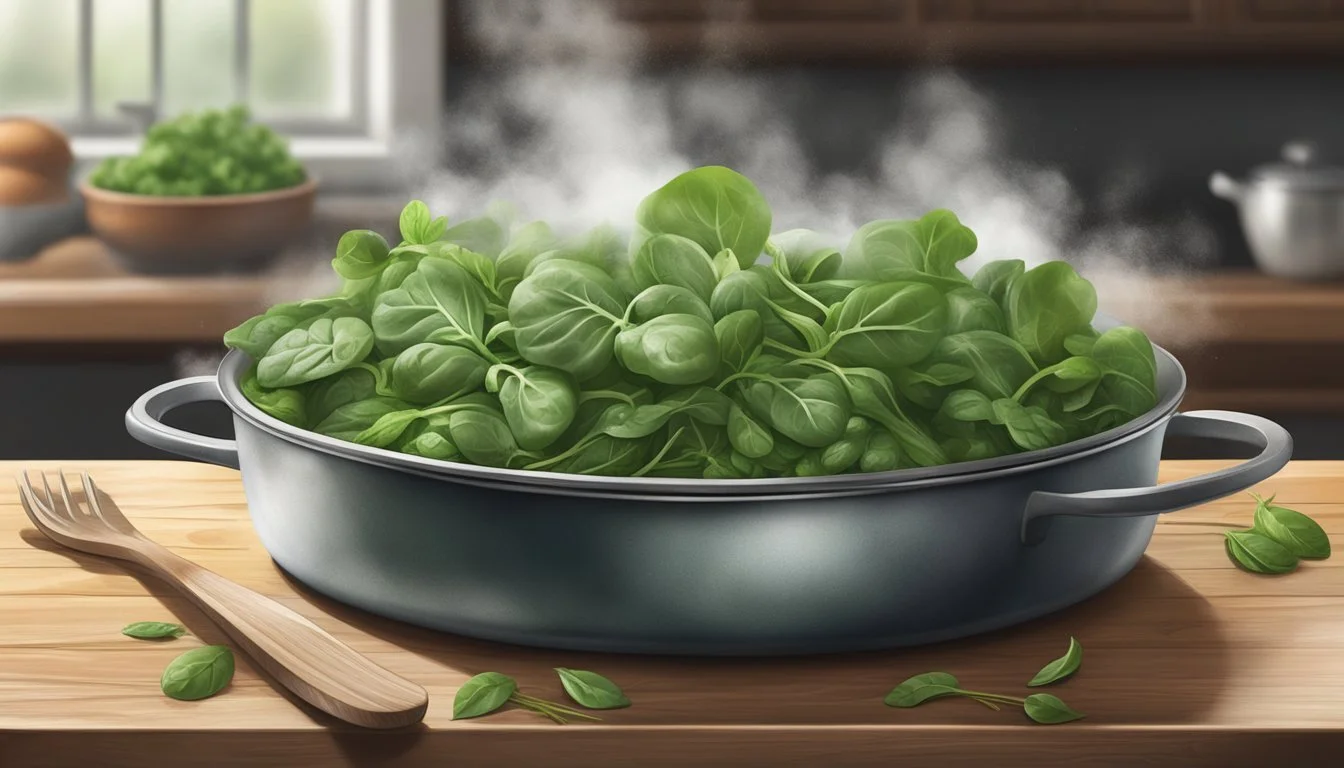How Long Does Chicken and Spinach Casserole Last?
Essential Storage Tips
Creamy, savory, and packed with nutrients, chicken and spinach casserole is a meal that brings warmth and comfort to any table. It's a delightful combination of tender chicken breasts, fresh spinach, and rich cheese, baked to perfection in the oven. Yet, many home cooks find themselves wondering about the shelf life of this flavorful dish.
Chicken and spinach casserole can last for up to 3-4 days in the refrigerator when stored properly in an airtight container. This makes it an excellent option for meal prep, allowing you to enjoy a delicious homemade meal even on the busiest of days. By taking a few simple steps to ensure your casserole is stored correctly, you can savor its rich flavors over multiple meals.
In addition to refrigeration, chicken and spinach casserole can also be frozen for longer storage. This flexibility not only helps in reducing food waste but also ensures you always have a wholesome meal ready to reheat. Whether kept in the fridge or the freezer, this dish remains a reliable and tasty option for those who appreciate both convenience and homemade goodness.
Recipe Overview
Chicken and spinach casserole is a delicious and comforting meal that combines tender chicken, fresh spinach, and a rich, creamy sauce.
Key Ingredients
Chicken: Use either chicken breasts or chicken thighs, depending on preference. Shredded chicken can also be utilized for convenience.
Spinach: Fresh spinach works best for this recipe. Ensure it is washed thoroughly before use.
Cream: Heavy cream creates a rich texture. Cream cheese also enhances the creamy consistency.
Cheeses: Incorporate both parmesan and mozzarella cheese. Parmesan adds a nutty flavor, while mozzarella contributes to the melted, gooey top.
Aromatics and Seasoning: Garlic, salt, black pepper, and Italian seasoning are essential. Olive oil or butter can be used for sautéing.
Preparation Steps
1. Prepare Ingredients: Preheat the oven to 375°F (190°C). Wash and chop the spinach. Shred the chicken if not already done.
2. Create Sauce: In a large pan, heat olive oil or butter. Sauté garlic until fragrant. Add heavy cream and cream cheese, stirring until melted and smooth.
3. Assemble: In a mixing bowl, combine the cooked chicken, spinach, and sauce. Mix well, ensuring that all ingredients are evenly coated with the sauce.
Baking Instructions
1. Preheat the Oven: Ensure the oven is preheated to 375°F (190°C) before placing the casserole inside.
2. Transfer Mixture: Pour the chicken and spinach mixture into a greased baking dish, spreading it out evenly.
3. Top with Cheese: Sprinkle parmesan and mozzarella cheese generously over the top of the casserole.
4. Bake: Place the baking dish in the preheated oven. Bake for 25-30 minutes, or until the cheese on top is golden and bubbly.
5. Serve: Allow the casserole to cool for a few minutes before serving for the best flavor and texture.
This combination of steps, ingredients, and careful preparation ensures a creamy, delicious chicken and spinach casserole suitable for any dinner table.
Storage Guidelines
For optimal freshness and to avoid any potential foodborne illnesses, it's critical to store chicken and spinach casserole correctly. Below are detailed guidelines for refrigeration and freezing to help preserve your meal.
Refrigeration
Chicken and spinach casserole should be stored in the fridge within two hours of cooking. Use an airtight container or the original baking dish covered tightly with aluminum foil or plastic wrap to maintain its moisture and flavor.
In the fridge, leftover casserole can last for up to 4 days. Labeling containers with the date is recommended to keep track of their freshness. Always reheat leftovers to an internal temperature of 165°F (74°C) before consuming.
Freezing and Thawing
For longer storage, consider freezing the casserole. Portion it into airtight containers or heavy-duty freezer bags. Ensure that no air remains inside to avoid freezer burn, which can affect the texture and taste.
Chicken and spinach casserole can be frozen for up to 3 months. When ready to use, thaw it in the fridge overnight. Do not thaw at room temperature to avoid bacterial growth. Once thawed, reheat thoroughly to ensure it has reached a safe internal temperature of 165°F (74°C).
Reheating Tips
Reheating a chicken and spinach casserole can be done using an oven or a microwave. Ensuring that the dish is heated evenly and reaches a safe internal temperature is crucial for both taste and safety.
Oven Reheating
Preheat the Oven: Set the oven to 350°F (175°C). This temperature is ideal for reheating casseroles evenly without drying them out.
Preparation: Cover the casserole dish with aluminum foil to retain moisture. If the dish appears dry, add a few tablespoons of chicken broth or water.
Heating Time: Reheat for 20-30 minutes. Check the casserole midway through and give it a gentle stir to distribute the heat evenly.
Internal Temperature: Use a food thermometer to ensure the internal temperature reaches 165°F (74°C). This ensures that the casserole is heated thoroughly and is safe to eat.
Serving: Carefully remove the dish from the oven, let it cool slightly, and enjoy your meal.
Microwave Reheating
Preparation: Place a portion of the casserole in a microwave-safe dish. Cover it with a microwave-safe lid or plastic wrap, leaving a small vent for steam to escape.
Microwave Settings: Set the microwave to medium power to prevent overcooking. High power can cause the dish to dry out or heat unevenly.
Heating Time: Microwave for 2-3 minutes per serving. Stir the casserole halfway through the heating time to ensure even reheating.
Internal Temperature: Check that the internal temperature of the casserole reaches 165°F (74°C). If needed, continue microwaving in 30-second intervals until the correct temperature is achieved.
Serving: Allow the dish to sit for a minute before serving so the heat can distribute evenly throughout the casserole.
Health and Nutrition
Chicken and spinach casserole provides a balance of macronutrients and several important vitamins and minerals. The dish can support various dietary needs and contribute to overall health.
Nutritional Breakdown
A typical serving of chicken and spinach casserole contains approximately 300-400 calories, depending on the specific recipe and portion size. The chicken offers a substantial source of protein, essential for muscle repair and growth.
Fat content varies but is generally healthy, containing about 15-20 grams, with saturated fat making up around 5 grams. Using lean chicken and reducing cheese can lower this. Cholesterol may be around 80-100 milligrams per serving, an important consideration for those monitoring their intake.
Carbohydrates typically fall between 20-30 grams per serving. Spinach adds dietary fiber which promotes digestion. This dish is also rich in Vitamin A, Vitamin C, Calcium, Potassium, and Iron, especially due to the spinach and various other vegetables that may be included.
Dietary Considerations
For those on a low-carb diet, the casserole's carbohydrate content can be managed by adjusting ingredients like omitting rice or using low-carb alternatives. Gluten-free modifications are also possible by ensuring all ingredients are free of gluten.
For individuals concerned about sodium, it's essential to use unsalted or low-sodium ingredients to keep the dish heart-friendly.
Lactose intolerant individuals can substitute dairy products with lactose-free or plant-based alternatives. Vegetarians might replace the chicken with plant-based protein sources like tofu or legumes, while vegans will need additional modifications to remove all animal products.
Lastly, the casserole provides valuable micronutrients from both the chicken and spinach, contributing to overall nutritional balance.
Variations and Substitutions
Chicken and spinach casserole is a versatile dish that allows for many variations. By adding different vegetables, proteins, and cheeses, you can customize the casserole to suit various tastes and dietary needs.
Vegetable Add-ins
Incorporating additional vegetables can enhance the flavor and nutritional value of the casserole. Bell peppers, asparagus, and cauliflower are excellent choices. Fresh or frozen spinach can be used interchangeably, though frozen spinach should be well-drained to prevent excess moisture.
Onions and garlic powder add a savory depth, while lemon juice can brighten the flavors. For a touch of sweetness, consider adding diced tomatoes or corn. These additions create a more complex and satisfying dish.
Protein Varieties
While chicken is a popular choice, other proteins can be used effectively. Sausage, either pork or chicken, can add a rich, smoky flavor. For a leaner option, turkey or tofu works well.
Marinated chicken breasts provide additional seasoning, and for a vegetarian option, substitute chickpeas or cooked lentils. Experimenting with different proteins allows for a new culinary experience each time the casserole is made.
Cheese Options
Cheese plays a vital role in providing creaminess and flavor. Parmesan cheese offers a sharp, salty taste that pairs well with spinach and chicken. Mozzarella provides a mild, gooey texture.
For a unique twist, try feta cheese, which brings a tangy, slightly salty flavor. Cream cheese can make the dish extra rich. Mixing different cheeses, like cheddar with Parmesan, can yield a balanced and interesting profile.
By considering these variations and substitutions, you can tailor the chicken and spinach casserole to match personal preferences, dietary restrictions, or simply to explore different culinary delights.
Tips for Making Ahead
Preparing a chicken and spinach casserole in advance is convenient and time-saving. The following steps outline the best practices for pre-assembly and overnight storage to ensure fresh and delicious results.
Pre-Assembly
Consider prepping the ingredients ahead of time. Pre-cook the chicken, wilt the spinach, and prepare the sauce. Store these components separately in airtight containers in the refrigerator.
Use fresh spinach for best results. If using frozen spinach, thaw and squeeze out excess moisture to avoid a watery dish.
When ready to assemble, layer the ingredients in a greased baking dish. Don’t combine the components too early to prevent sogginess. Mix the ingredients shortly before baking to maintain optimal texture and flavor.
By preparing key components ahead, you significantly reduce the overall prep time when it's time to cook.
Overnight Storage
After assembling the casserole in the baking dish, cover it tightly with plastic wrap or aluminum foil. Store it in the refrigerator for up to 24 hours before baking. This allows the flavors to meld while ensuring the dish remains fresh.
When ready to bake, preheat the oven and remove the casserole from the fridge. Let it sit at room temperature for about 20 minutes.
This step helps prevent the dish from cracking due to a sudden temperature change. Bake as instructed, adjusting the cooking time if necessary to ensure it is heated through.
Following these tips will help maintain the casserole's quality and taste.
Serving Suggestions
Chicken and spinach casserole pairs well with various sides that enhance its flavors and create a complete meal. Popular accompaniments include garlic bread, mashed potatoes, and ranch dressing.
Side Dishes
Garlic Bread
Garlic bread is a fantastic side to chicken and spinach casserole. The crispy texture and savory garlic flavor of the bread complement the creamy casserole. For the best results, serve it warm with a slight drizzle of olive oil or a sprinkle of parmesan cheese.
Mashed Potatoes
Mashed potatoes are another excellent option. Their creamy texture aligns well with the casserole, creating a harmonious blend of flavors. Simply add a touch of butter and a hint of garlic to bring out the rich taste.
Noodles
Noodles make a versatile side dish. Egg noodles or pasta tossed in a light herb butter work beautifully. They serve as a neutral base, allowing the casserole’s flavors to stand out.
Accompaniments
Ranch Dressing
Ranch dressing is a quick and easy accompaniment. A drizzle over the casserole can add a tangy kick that enhances the overall flavor.
Fresh Salad
A fresh salad with mixed greens, cherry tomatoes, and a light vinaigrette provides a refreshing contrast. This is ideal for weeknight dinners when a balanced meal is desired.
Steamed Vegetables
Steamed vegetables, such as broccoli or carrots, add a healthy component. Lightly seasoned with salt and pepper, they bring a simple, nutritious touch to the dish.
These suggestions ensure a satisfying and well-rounded meal, perfect for any casual dinner or a more formal gathering.
Customization Ideas
Creating a chicken and spinach casserole opens up a world of customization options to suit your taste preferences and dietary needs. Experiment with different ingredients and preparation methods for a unique take on this classic dish.
Creative Twists
Adding various vegetables can bring new flavors and textures to your casserole.
Fresh baby spinach is versatile and can pair well with other greens, such as kale or Swiss chard.
Shredded cheese adds richness. Mixing different cheeses, like mozzarella, cheddar, and parmesan, can provide a deeper flavor profile.
For an extra creamy touch, incorporate ingredients like sour cream or Greek yogurt to the sauce.
Spices make a difference. Try adding garlic powder, smoked paprika, or a pinch of nutmeg.
Adding breadcrumbs on top for a crispy finish can make it more appealing.
Ingredient Swaps
Swapping boneless skinless chicken breasts with boneless skinless chicken thighs can alter the texture and flavor, making it juicier.
For those preferring a lighter dish, substitute the creamy sauce with a broth-based sauce.
Replace white rice with quinoa or cauliflower rice for a lower-carb option.
Using non-dairy milk and vegan cheese can make the casserole suitable for those with dairy sensitivities.
Utilize canned or fresh tomatoes for a tangier flavor and more moisture.
Swap fresh baby spinach with frozen spinach if preferred, ensuring it's well-drained to avoid extra moisture in the dish.
Safety and Food Handling
Ensuring the safety of a chicken and spinach rice casserole involves cooking and reheating to proper temperatures and preventing cross-contamination in the kitchen. Proper techniques help maintain food safety and quality.
Cooking to Safe Temperatures
When preparing a chicken spinach rice casserole, it’s essential to cook the chicken to an internal temperature of at least 165°F (74°C). This ensures that harmful bacteria like Salmonella are destroyed. Similarly, spinach and rice should be cooked thoroughly to avoid potential risks.
Using a food thermometer can help verify temperatures without guesswork. When reheating leftovers, the casserole should again reach 165°F (74°C) to ensure safety.
Avoiding Cross-Contamination
Preventing cross-contamination starts with separating raw chicken from other ingredients like spinach and cooked rice. Use different cutting boards for raw meat and vegetables. Wash your hands, utensils, and surfaces thoroughly after handling raw chicken.
Store the ingredients in sealed containers in the fridge to prevent exposure to contaminants. When mixing or handling the casserole, ensure that cooked and uncooked items do not come into contact until cooking is complete.

